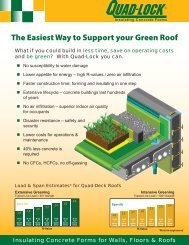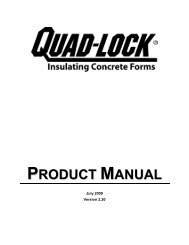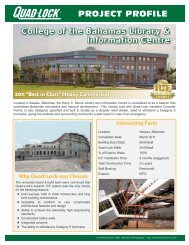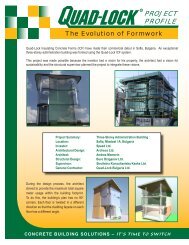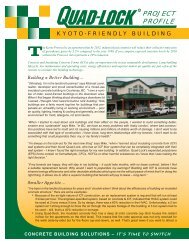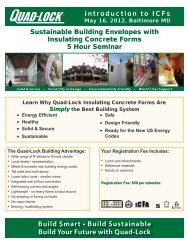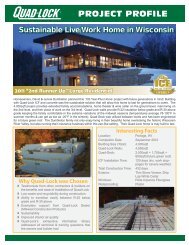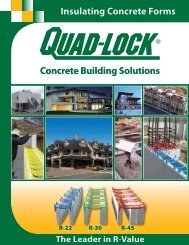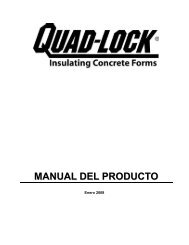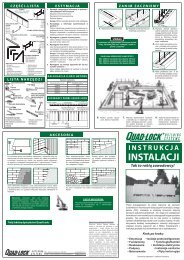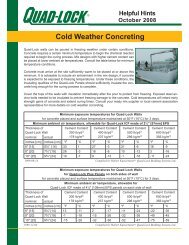Expanded Polystyrene (EPS) and the Environment - The BPF ...
Expanded Polystyrene (EPS) and the Environment - The BPF ...
Expanded Polystyrene (EPS) and the Environment - The BPF ...
Create successful ePaper yourself
Turn your PDF publications into a flip-book with our unique Google optimized e-Paper software.
<strong>Exp<strong>and</strong>ed</strong><br />
<strong>Polystyrene</strong><br />
(<strong>EPS</strong>)<br />
<strong>and</strong> <strong>the</strong><br />
<strong>Environment</strong><br />
Introduction<br />
<strong>The</strong> impact on <strong>the</strong> environment of everyday materials is increasingly<br />
important if we are to reduce our carbon footprint <strong>and</strong> protect our<br />
natural heritage for future generations. Our aim, <strong>the</strong>refore, in this booklet<br />
is to provide you with factual, well-documented information about <strong>the</strong><br />
environmental credentials of <strong>EPS</strong>.<br />
<strong>EPS</strong> (exp<strong>and</strong>ed polystyrene) is an excellent material for packaging<br />
<strong>and</strong> for construction as it is a light yet rigid foam with good <strong>the</strong>rmal<br />
insulation <strong>and</strong> high impact resistance.<br />
This publication aims to provide balanced information based on <strong>the</strong><br />
manufacture, use <strong>and</strong> recovery from waste of <strong>EPS</strong> in <strong>the</strong> packaging <strong>and</strong><br />
construction sectors.<br />
We also aim to demonstrate to customers, government organisations,<br />
consumer associations <strong>and</strong> <strong>the</strong> public that, by choosing or using <strong>EPS</strong>,<br />
you can be confident it is safe, complies with all relevant technical <strong>and</strong><br />
environmental st<strong>and</strong>ards <strong>and</strong> can easily be recycled at <strong>the</strong> end of its<br />
primary use.
What is <strong>EPS</strong>?<br />
Raw Material<br />
<strong>Exp<strong>and</strong>ed</strong> polystyrene is made<br />
from exp<strong>and</strong>able polystyrene,<br />
which is a rigid cellular plastic<br />
containing an expansion agent.<br />
<strong>EPS</strong> is obtained from oil as can be<br />
seen from <strong>the</strong> diagram.<br />
Ethanes<br />
Diesel Fuel<br />
Fuel Oils<br />
Jet Fuel<br />
FUELS<br />
Gasoline<br />
Kerosene<br />
Liquid<br />
Petroleum Gas<br />
Natural Gas<br />
Generally used in transportation, power<br />
plants <strong>and</strong> heating. Normally results in<br />
<strong>the</strong> destruction of <strong>the</strong> material while<br />
generating energy.<br />
<strong>Exp<strong>and</strong>ed</strong> <strong>Polystyrene</strong> (<strong>EPS</strong>) is a rigid cellular plastic, which is<br />
found in a multitude of shapes <strong>and</strong> applications. It is used for fish<br />
boxes, packaging for electrical consumer goods <strong>and</strong> for<br />
insulation panels for building. <strong>The</strong>se are <strong>the</strong> most commonly<br />
known uses <strong>and</strong> we will mention o<strong>the</strong>rs in this document.<br />
XPS (extruded polystyrene) is also plastic foam based on<br />
polystyrene that is formed by adding gas during extrusion not<br />
by exp<strong>and</strong>ing beads containing gas; which is how <strong>EPS</strong> is formed.<br />
A well-known use of XPS is <strong>the</strong> vac-formed polystyrene trays<br />
used for small portions of food that we see in <strong>the</strong> supermarket.<br />
<strong>The</strong> extruded polystyrene foam is a fine laminate that is only<br />
2-3 mm thick.<br />
CRUDE<br />
OIL<br />
DISTILLATION<br />
HYDROCARBON<br />
SEPARATION<br />
PLASTICS<br />
4%<br />
<strong>EPS</strong><br />
0·1%<br />
OTHER<br />
DERIVATIVES<br />
Alkenes<br />
Lubricants<br />
Wax<br />
Sulfur or<br />
Sulfuric Acid<br />
OTHERS<br />
96%<br />
Bulk tar<br />
Asphalt<br />
Petroleum<br />
Coke<br />
Paraffin wax<br />
Over 4000 products, compounds<br />
through polymerisation processes,<br />
motor oils <strong>and</strong> greases, acids <strong>and</strong><br />
fur<strong>the</strong>r derivatives<br />
EXPANDED POLYSTYRENE (<strong>EPS</strong>) AND THE ENVIRONMENT PAGE 2
Manufacturing Process<br />
We can see from <strong>the</strong> diagram that <strong>EPS</strong> is brought to us from <strong>the</strong> oil well through a chemical process. Now we will see what<br />
happens in <strong>the</strong> transformation that leads us to <strong>Exp<strong>and</strong>ed</strong> <strong>Polystyrene</strong> (<strong>EPS</strong>).<br />
<strong>The</strong> conversion of exp<strong>and</strong>able polystyrene to exp<strong>and</strong>ed polystyrene is carried out in three stages.<br />
RAW<br />
MATERIAL<br />
BLOCKS<br />
MOULDING<br />
BLOCK<br />
CUTTING<br />
PLANT<br />
1st stage<br />
Pre-expansion<br />
<strong>The</strong> raw material is heated in special<br />
machines called pre-exp<strong>and</strong>ers with<br />
steam at temperatures of between<br />
80-100°C. <strong>The</strong> density of <strong>the</strong> material<br />
falls from some 630kg/m 3 to values of<br />
between 10 <strong>and</strong> 35kg/m 3 .<br />
During this process of preexpansion<br />
<strong>the</strong> raw material’s compact<br />
beads turn into cellular plastic beads<br />
with small closed cells that hold air in<br />
<strong>the</strong>ir interior.<br />
SILOS<br />
PRE-<br />
EXPANDER<br />
SHAPE<br />
MOULDING<br />
BOARDS MOULDED<br />
ARTICLES<br />
PRE-<br />
EXPANSION 1<br />
INTERMEDIATE<br />
MATURING<br />
FINAL<br />
MOULDING<br />
2nd stage<br />
Intermediate Maturing <strong>and</strong><br />
Stabilisation<br />
On cooling, <strong>the</strong> recently exp<strong>and</strong>ed particles<br />
from a vacuum in <strong>the</strong>ir interior <strong>and</strong> this must<br />
be compensated for by air diffusion. This<br />
process is carried out during <strong>the</strong> material’s<br />
intermediate maturing in aerated silos. <strong>The</strong><br />
beads are dried at <strong>the</strong> same time.<br />
This is how <strong>the</strong> beads achieve greater<br />
mechanical elasticity <strong>and</strong> improve expansion<br />
capacity — very important in <strong>the</strong> following<br />
transformation stage.<br />
EXPANDED POLYSTYRENE (<strong>EPS</strong>) AND THE ENVIRONMENT PAGE 3<br />
2<br />
3<br />
3rd stage<br />
Expansion <strong>and</strong> Final<br />
Moulding<br />
During this stage, <strong>the</strong> stabilised<br />
pre-exp<strong>and</strong>ed beads are<br />
transported to moulds where<br />
<strong>the</strong>y are again subjected to steam<br />
so that <strong>the</strong> beads bind toge<strong>the</strong>r.<br />
In this way moulded shapes<br />
or large blocks are obtained<br />
(that are later sectioned to <strong>the</strong><br />
required shape like boards,<br />
panels, cylinders etc).
Applications <strong>and</strong> Properties of <strong>EPS</strong><br />
<strong>The</strong> range of applications for exp<strong>and</strong>ed polystyrene is very wide. We are going to focus on <strong>the</strong>se applications by putting<br />
<strong>the</strong>m into three main categories <strong>and</strong> underline <strong>the</strong> properties that make <strong>EPS</strong> ideal for each one.<br />
<strong>The</strong> three categories are:<br />
l Packaging<br />
l Construction<br />
l O<strong>the</strong>r applications<br />
Packaging<br />
Any product of any shape or size may be packaged in exp<strong>and</strong>ed polystyrene. <strong>The</strong> following range of applications only<br />
scratches <strong>the</strong> surface of what could be possible. <strong>The</strong> following only scratches <strong>the</strong> surface of what is possible in both <strong>the</strong><br />
industrial <strong>and</strong> food packaging sectors using <strong>EPS</strong><br />
Packing Products<br />
<strong>EPS</strong> is <strong>the</strong> best packaging option for almost any high value heavy product. Completely<br />
protected <strong>and</strong> safe from risk in transport <strong>and</strong> h<strong>and</strong>ling, <strong>EPS</strong> provides total protection for<br />
industrial products.<br />
<strong>The</strong>se range from fragile pharmaceutical products to electronic components, electrical<br />
consumer goods, toys through to horticultural or garden products. All of <strong>the</strong>se, <strong>and</strong> more,<br />
are able to arrive at <strong>the</strong>ir destination — often <strong>the</strong> home of <strong>the</strong> consumer — in perfect<br />
condition courtesy of <strong>the</strong>ir <strong>EPS</strong> packaging.<br />
<strong>EPS</strong> can be designed to fit perfectly into automated production lines, which include <strong>the</strong><br />
packing of <strong>the</strong> product. <strong>The</strong> <strong>EPS</strong> pack adapts superbly to integrated production systems.<br />
<strong>The</strong> <strong>EPS</strong> packaging system is often <strong>the</strong> best alternative in terms of cost, versatility <strong>and</strong><br />
efficiency. It is easy for workers to h<strong>and</strong>le with no sharp edges or staples <strong>and</strong> can work<br />
equally well with sophisticated machinery.<br />
Food Packaging<br />
Fish <strong>and</strong> shellfish, meat, fruit, ice cream — <strong>EPS</strong> packaging is <strong>the</strong> best way of keeping any foodstuff fresh. <strong>The</strong> perfect<br />
protection avoids hazards, breakages <strong>and</strong> wastage in <strong>the</strong> different stages of production <strong>and</strong> transport. Every day <strong>EPS</strong><br />
packaging is ensuring that many different foods reach <strong>the</strong> retailer or <strong>the</strong> final consumer in perfect condition.<br />
Food safety is paramount; a badly protected or poorly insulated product could arrive in a subst<strong>and</strong>ard condition. This could<br />
be a serious health risk to consumers or a serious wastage issue for a supermarket or food supplier.<br />
This is an important ecological benefit of <strong>EPS</strong>. Its capacity to conserve food helps to reduce wastage of food <strong>and</strong> guarantees<br />
food safety.<br />
New Applications for Moulded <strong>EPS</strong><br />
<strong>The</strong> versatility of <strong>EPS</strong> — it can be moulded into almost any shape — allows it to be used for a huge variety of different purposes.<br />
Examples include:<br />
l Chairs – as designed by Tom Dixon<br />
l Book covers – designed by Jonathan Ive for Sir Paul Smith’s book<br />
l Exhibition st<strong>and</strong> – designed by Michael Sodeau<br />
l Snow sports helmet<br />
l Infant car seats<br />
l Air conditioning units<br />
l Houses<br />
l Seating for sports – Formula 1 cars <strong>and</strong> para-Olympic sailors<br />
l Frog houses<br />
l load-bearing structurally insulated panels (SIP’s)<br />
EXPANDED POLYSTYRENE (<strong>EPS</strong>) AND THE ENVIRONMENT PAGE 4
Properties of <strong>EPS</strong><br />
<strong>The</strong> following properties make <strong>EPS</strong> a perfect packaging material:<br />
Retention of vitamin C<br />
When packed in <strong>EPS</strong>, fruits <strong>and</strong> vegetables<br />
retain <strong>the</strong>ir vitamin C content longer than<br />
food packaging in o<strong>the</strong>r materials.<br />
Resistance to humidity<br />
<strong>The</strong> excellent mechanical <strong>and</strong> <strong>the</strong>rmal<br />
properties are unaffected by humidity<br />
because <strong>EPS</strong> does not absorb water or<br />
water vapour.<br />
Compressive resistance<br />
<strong>The</strong> unique ability of <strong>EPS</strong> to resist compression makes it<br />
ideal for packing large items such as cookers <strong>and</strong> washing<br />
machines. Not only does <strong>EPS</strong> protect <strong>the</strong>m in transit, but <strong>the</strong>y<br />
can be stacked in <strong>the</strong> warehouse, saving on space <strong>and</strong> without any<br />
damage to <strong>the</strong> items.<br />
Chemical resistance<br />
Allows many products to be packed without <strong>the</strong> goods being affected.<br />
Shock absorption<br />
<strong>The</strong> material has a high energy absorption index. This makes it<br />
<strong>the</strong> ideal material for protecting sensitive products during<br />
transport <strong>and</strong> storage.<br />
This unique level of protection makes <strong>EPS</strong> ideally<br />
suited for safety <strong>and</strong> sports helmets <strong>and</strong> for<br />
children’s car seats.<br />
<strong>The</strong>rmal insulation<br />
Due to its closed cell structure, which<br />
inhibits <strong>the</strong> passage of heat or cold, <strong>EPS</strong> has<br />
a high capacity for <strong>the</strong>rmal insulation. This<br />
protects products such as vaccines or o<strong>the</strong>r<br />
pharmaceutical items <strong>and</strong> food such as fish <strong>and</strong><br />
meat from sudden changes in temperature.<br />
Low weight<br />
<strong>EPS</strong> is 98% air making it <strong>the</strong> lightest packaging<br />
material available. This reduces <strong>the</strong> overall packaging<br />
weight <strong>and</strong> provides savings in fuel consumption —<br />
reducing <strong>the</strong> environmental impact of transporting products.<br />
Display effect to promote sales<br />
<strong>EPS</strong> can easily be printed or coloured, it has a clean appealing appearance <strong>and</strong> can be used in many different ways<br />
to dress products to attract customers.<br />
Hygienic nature<br />
<strong>EPS</strong> is completely inert <strong>and</strong> innocuous, it meets all <strong>the</strong> food contact regulatory st<strong>and</strong>ards <strong>and</strong> can be used to<br />
package food or pharmaceuticals.<br />
EXPANDED POLYSTYRENE (<strong>EPS</strong>) AND THE ENVIRONMENT PAGE 5
Applications as a Construction Material<br />
<strong>EPS</strong> is used in many aspects of building work including large structures such as roads, bridges, railway lines, public<br />
buildings or even small family residences.<br />
<strong>The</strong> characteristics of <strong>EPS</strong> make it ideal for use as a lightweight filler, insulation, as an element for decorating or<br />
imaginative touches, as a lightweight filling material in roads, to facilitate l<strong>and</strong> drainage <strong>and</strong> so on.<br />
We could visit any construction or building site <strong>and</strong> find products made from <strong>EPS</strong> carrying out diverse <strong>and</strong> important<br />
functions.<br />
<strong>The</strong> following properties are important for <strong>the</strong>se applications:<br />
Low <strong>the</strong>rmal<br />
conductivity<br />
Due to its closed air-filled cell<br />
structure that inhibits <strong>the</strong><br />
passage of heat or cold, a high<br />
capacity for <strong>the</strong>rmal insulation<br />
is achieved.<br />
Low weight<br />
Densities of between 10 <strong>and</strong><br />
35kg/m 2 allow light <strong>and</strong> safe<br />
construction works<br />
Mechanical resistance<br />
<strong>EPS</strong> has excellent mechanical<br />
properties making it good<br />
choice for load-bearing roof<br />
insulation, sub-pavement<br />
flooring, road-building, as loadbearing<br />
insulation, <strong>and</strong> so on.<br />
Low water absorption<br />
<strong>EPS</strong> does not absorb moisture<br />
<strong>and</strong> its <strong>the</strong>rmal <strong>and</strong> mechanical<br />
properties are unaffected by damp, humidity or moisture.<br />
-50% CO2<br />
50% OF CO2 EMISSIONS<br />
CAN BE AVOIDED BY<br />
USING <strong>EPS</strong> INSULATION<br />
Ease of h<strong>and</strong>ling <strong>and</strong> installation<br />
<strong>The</strong> material can be h<strong>and</strong>led in <strong>the</strong> usual way. You are guaranteed a<br />
perfect finish. <strong>The</strong> low weight of <strong>EPS</strong> makes it easy to h<strong>and</strong>le <strong>and</strong> to<br />
transport to site.<br />
Chemical resistance<br />
<strong>EPS</strong> is completely compatible with o<strong>the</strong>r materials used in construction<br />
including cements, plasters, salt, fresh water <strong>and</strong> so on.<br />
Versatility<br />
<strong>EPS</strong> can be cut into <strong>the</strong> shape or size required by <strong>the</strong> construction project.<br />
Ageing resistance<br />
All of <strong>the</strong> properties listed above are retained over <strong>the</strong> whole of <strong>the</strong><br />
material’s life <strong>and</strong> will last as long as <strong>the</strong> building itself. <strong>EPS</strong> is not<br />
altered by external agents such as fungi or parasites as <strong>the</strong>y find no<br />
nutritional value in <strong>the</strong> material.<br />
EXPANDED POLYSTYRENE (<strong>EPS</strong>) AND THE ENVIRONMENT PAGE 6
Life Cycle Analysis<br />
A life cycle analysis is a technique intended to quantify <strong>the</strong> total impact of a product during its production, distribution, use<br />
<strong>and</strong> recycling, treatment or disposal.<br />
As individuals, <strong>and</strong> as organisations, all our daily actions have an impact on <strong>the</strong> environment. We use energy <strong>and</strong> resources,<br />
generate emissions into <strong>the</strong> atmosphere, pollute water <strong>and</strong> produce waste.<br />
One of <strong>the</strong> tasks of a responsible business is to calculate its impact on <strong>the</strong> environment <strong>and</strong> to find ways to reduce it.<br />
However, some businesses use concern about <strong>the</strong> environment as a marketing tool <strong>and</strong> make claims that <strong>the</strong>ir products or<br />
materials are ‘environmentally-friendly’ or have a low carbon footprint.<br />
Responsible organisations will ei<strong>the</strong>r conduct a thorough life-cycle analysis of a product, or calculate its carbon footprint<br />
using Carbon Trust methodology, (making <strong>the</strong>ir research public) before making statements of this kind<br />
Reliable life cycle analyses will measure:<br />
l Energy consumption<br />
l Air pollution<br />
l Water pollution<br />
l Global warming potential<br />
l Volume of solid waste<br />
This table shows <strong>the</strong> results of<br />
a life cycle analysis that made a<br />
comparison of <strong>EPS</strong> with o<strong>the</strong>r<br />
materials. <strong>The</strong> data demonstrates<br />
that <strong>EPS</strong> packaging has much<br />
less impact on <strong>the</strong> environment<br />
than o<strong>the</strong>r competitive materials<br />
for <strong>the</strong> same use.<br />
VENDING MACHINES<br />
CUPS (1)<br />
CHEMICALS<br />
ELECTRICITY<br />
COOLING WATER<br />
PROCESS WATER<br />
STEAM<br />
CRUDE PETROLEUM<br />
SHAPED / MOULDED<br />
PACKAGING (2)<br />
ENERGY CONSUMPTION<br />
AIR POLLUTION<br />
WATER POLLUTION<br />
GLOBAL WARMING POTENTIAL<br />
<strong>EPS</strong><br />
CUPS<br />
EXPANDED POLYSTYRENE (<strong>EPS</strong>) AND THE ENVIRONMENT PAGE 7<br />
1<br />
15<br />
1 13<br />
1<br />
1·3<br />
1 170<br />
1<br />
PAPER<br />
CUPS<br />
6<br />
1 0·6<br />
<strong>EPS</strong><br />
1<br />
2·3 – 3·8<br />
1 3·1 – 4·1<br />
1<br />
PULP AND<br />
FIBREBOARD<br />
2·3 – 2·8<br />
1 4·0 – 4·4<br />
VOLUME OF SOLID WASTE 1 0·69 – 0·79<br />
PACKAGING<br />
MATERIALS (3)<br />
COST<br />
WEIGHT<br />
ENERGY CONSUMPTION<br />
VOLUME OF SOLID WASTE<br />
<strong>EPS</strong><br />
1<br />
1·3<br />
1 6·4<br />
1<br />
WOOD,<br />
PAPER, ETC.<br />
2·0<br />
1 1·2
Questions about <strong>the</strong> effects of <strong>EPS</strong> on <strong>the</strong> <strong>Environment</strong><br />
Efficient Use of Natural Resources<br />
Overall, some 90% of all <strong>the</strong> derivatives<br />
of crude oil are transformed into energy<br />
in one form or ano<strong>the</strong>r, as transportation<br />
fuel, for electricity generation <strong>and</strong> for<br />
heating. Only 4% is used as raw material<br />
for making plastics.<br />
HEATING FUEL SAVINGS IN HOUSES AND<br />
BUILDINGS USING <strong>EPS</strong> INSULATION<br />
WITHOUT INSULATION WITH <strong>EPS</strong><br />
Using <strong>EPS</strong> to package a product<br />
will result in a reduction in fuel<br />
consumption compared to o<strong>the</strong>r<br />
materials.<br />
OIL EXPENDITURE<br />
ON HEATING FUEL<br />
Using oil to manufacture products in <strong>EPS</strong> can<br />
be an efficient use of this natural resource, for<br />
example:<br />
Each kilogram of oil used to produce <strong>EPS</strong><br />
insulation panels creates a saving of 150kg of<br />
oil used for heating residences <strong>and</strong> buildings<br />
(calculated over a 50 year period).<br />
WITH GLASS WITH PLASTICS<br />
57% 43%<br />
PRODUCT<br />
WEIGHT<br />
PACKAGING<br />
WEIGHT<br />
FUEL SAVING<br />
EXPANDED POLYSTYRENE (<strong>EPS</strong>) AND THE ENVIRONMENT PAGE 8<br />
93%<br />
7%<br />
39%
Questions about <strong>the</strong> effects of <strong>EPS</strong> on <strong>the</strong> <strong>Environment</strong> continued<br />
Styrene<br />
<strong>The</strong> monomer styrene, used in <strong>the</strong> manufacture of exp<strong>and</strong>able polystyrene, has been<br />
manufactured for more than 60 years <strong>and</strong> is used for a wide range of plastics<br />
<strong>and</strong> plastic products.<br />
Styrene also exists naturally <strong>and</strong> can be found in many foodstuffs<br />
including strawberries, beans, nuts, beer, wine, coffee beans <strong>and</strong><br />
cinnamon.<br />
Exhaustive research into <strong>the</strong> health effects of styrene has shown that<br />
although high exposure levels can be dangerous, like most chemical<br />
products, styrene is perfectly safe for normal use.<br />
Based on <strong>the</strong> current EU classifications <strong>and</strong> <strong>the</strong> current draft of <strong>the</strong> UK’s<br />
risk assessment report, styrene monomer is considered to have low oral<br />
toxicity, <strong>and</strong> is not classified in terms of carcinogenicity or mutagenicity.<br />
l For more info visit www.styreneforum.org<br />
Pentane<br />
Pentane, a non-CFC expansion agent is used during <strong>the</strong> <strong>EPS</strong> production process to exp<strong>and</strong> <strong>the</strong> polystyrene granules into a<br />
cellular structure.<br />
Pentane is a slightly volatile liquid that is continually formed in natural processes. For example, it appears in <strong>the</strong> digestive<br />
systems of animals <strong>and</strong> in <strong>the</strong> anaerobic decomposition of vegetable matter by micro-organisms.<br />
It belongs to <strong>the</strong> same chemical family as o<strong>the</strong>r better known gases like methane, ethane, propane <strong>and</strong> butane which are<br />
used as heating fuel.<br />
Pentane released during <strong>the</strong> <strong>EPS</strong> manufacturing process quickly turns into<br />
carbon dioxide <strong>and</strong> water in a photochemical reaction. It does not contain<br />
chlorine <strong>and</strong> so does not harm <strong>the</strong> ozone layer like CFCs or HCFCs.<br />
Although <strong>the</strong> pentane released during <strong>the</strong> production <strong>and</strong><br />
transformation of <strong>EPS</strong> does contribute to man-made emissions<br />
of volatile organic compounds (VOCs) – <strong>the</strong>se are only found in<br />
<strong>the</strong> 0-0.2% range<br />
Much greater quantities of methane are generated from <strong>the</strong><br />
decomposition of human waste. Professor Hocking of <strong>the</strong> University<br />
of Victoria in Canada has recently shown that <strong>the</strong> methane released<br />
by decomposing st<strong>and</strong>ard size paper cups is 50 times higher than <strong>the</strong><br />
quantity of pentane released in processing <strong>EPS</strong> cups.<br />
<strong>The</strong> <strong>EPS</strong> industry is researching new ways to reduce <strong>the</strong> levels of pentane used <strong>and</strong> to capturing <strong>and</strong> re-using pentane.<br />
Pentane is not considered to be a substance hazardous to health by European health authorities.<br />
<strong>The</strong> Manufacturing Process<br />
Steam is used as energy in <strong>the</strong> manufacturing of <strong>EPS</strong>. <strong>The</strong> steam itself is produced in boilers mainly using natural gas as fuel.<br />
Water consumption used in <strong>the</strong> manufacture of <strong>EPS</strong> is very low. <strong>The</strong> water is reused many times in <strong>the</strong> process.<br />
<strong>The</strong>re is no solid waste generated during <strong>the</strong> <strong>EPS</strong> manufacturing process. Waste <strong>and</strong> off-cuts are easily put back into <strong>the</strong><br />
production process.<br />
No material is wasted <strong>and</strong> clean used packaging can be recycled into new product using this method.<br />
<strong>The</strong>re is no pollution to <strong>the</strong> surface or underground water supplies near an <strong>EPS</strong> plant because atmospheric <strong>and</strong> liquid<br />
emissions are very low during <strong>the</strong> manufacture of <strong>EPS</strong>.<br />
EXPANDED POLYSTYRENE (<strong>EPS</strong>) AND THE ENVIRONMENT PAGE 9
Waste Management<br />
<strong>EPS</strong> is a highly visual material because it is both bulky <strong>and</strong> predominantly white. This high visibility factor makes it appear<br />
that large amounts of used <strong>EPS</strong> are thrown away. In fact this is not <strong>the</strong> case. <strong>EPS</strong> is only 0.1 per cent of Municipal Solid Waste<br />
(MSW).<br />
Reduce<br />
<strong>The</strong> <strong>BPF</strong>’s <strong>EPS</strong> Packaging Group works hard to support <strong>and</strong> encourage <strong>the</strong> responsible waste management of used <strong>EPS</strong>. In<br />
<strong>the</strong> first instance, that means reducing <strong>the</strong> amount of material that is used in a pack.<br />
CAD design, prototypes <strong>and</strong> thorough testing are used to ensure that an <strong>EPS</strong> pack does <strong>the</strong> job required whilst using <strong>the</strong><br />
smallest possible amount of material.<br />
Recycling<br />
<strong>EPS</strong> is 100% recyclable <strong>and</strong> thous<strong>and</strong>s of tonnes are recycled every year in <strong>the</strong> UK.<br />
<strong>The</strong> <strong>BPF</strong>’s <strong>EPS</strong> Packaging Group works hard to encourage <strong>and</strong> support <strong>the</strong> recycling of <strong>EPS</strong>, providing information <strong>and</strong><br />
advice through its website www.eps.co.uk <strong>and</strong> email info@eps.co.uk.<br />
Many businesses in <strong>the</strong> UK have set up recycling schemes for <strong>the</strong>ir used <strong>EPS</strong>. Some have <strong>the</strong>ir material collected uncompacted;<br />
this is recycled into insulation board for use in construction.<br />
O<strong>the</strong>rs invest in compacting machinery which reduces <strong>the</strong> size of <strong>the</strong>ir <strong>EPS</strong> by between 40-95%. <strong>The</strong> material is <strong>the</strong>n<br />
transportable <strong>and</strong> can be sold to a recycler.<br />
This compacted material can be transformed into recycled polystyrene pellets. <strong>The</strong>se pellets are used to manufacture coat<br />
hangers, picture frames, replacement hardwood <strong>and</strong> CD cases.<br />
Some of <strong>the</strong> members of <strong>the</strong> <strong>EPS</strong> Packaging Group have set up consumer recycling points on <strong>the</strong>ir sites so that local<br />
people <strong>and</strong> small businesses can recycle <strong>the</strong>ir used polystyrene. This material is ground down <strong>and</strong> put back into new<br />
packaging.<br />
See www.eps.co.uk/recycling for more information.<br />
Energy Recovery<br />
Ano<strong>the</strong>r way to extract value from used<br />
plastics is to clean burn <strong>the</strong>m to recover<br />
<strong>the</strong> energy <strong>and</strong> avoid <strong>the</strong> flow of waste to<br />
l<strong>and</strong>fill. Waste combustion for electricity<br />
or heat generation is an effective way to<br />
maximise usage <strong>and</strong> benefit of plastic<br />
material resources <strong>and</strong> is widely used in<br />
Europe, although not currently in <strong>the</strong> UK.<br />
<strong>EPS</strong> has a high calorific value. One<br />
kilogram of exp<strong>and</strong>ed polystyrene contains<br />
as much energy as 1.3 litres of heating fuel.<br />
<strong>The</strong> waste deposited in <strong>the</strong> bins of one<br />
household over a year contains enough<br />
energy to heat water for 500 baths or<br />
to keep <strong>the</strong> television switched on for<br />
5,000 hours.<br />
48,000<br />
NATURAL<br />
GAS<br />
46,000<br />
PLASTICS<br />
(PE,PP,PS)<br />
44,000<br />
FUEL-OIL<br />
29,000<br />
CALORIFIC VALUE (kJ/kg)<br />
<strong>The</strong>re are no toxic emissions in this method of waste management of <strong>EPS</strong>. It is incinerated in modern plants <strong>and</strong> at high<br />
temperatures. <strong>The</strong> by- products are steam, carbon dioxide <strong>and</strong> very low levels of non-toxic ash. <strong>The</strong>se emissions are less<br />
contaminating than <strong>the</strong> typical camp fire.<br />
L<strong>and</strong>fill<br />
L<strong>and</strong>fill is <strong>the</strong> least desirable option among all <strong>the</strong> waste management alternatives we have considered up to now. Putting<br />
<strong>EPS</strong> into l<strong>and</strong>fill means that we not making <strong>the</strong> best of our natural resources ei<strong>the</strong>r through recycling or energy recovery.<br />
But, if <strong>the</strong>re is no feasible alternative <strong>EPS</strong> can be safely put into l<strong>and</strong>fill. It is inert, non-toxic <strong>and</strong> stable. As it does not<br />
decompose, <strong>EPS</strong> does not contribute to <strong>the</strong> formation of methane or any o<strong>the</strong>r chemicals in <strong>the</strong> atmosphere <strong>and</strong> it does not<br />
pollute subterranean water supplies.<br />
EXPANDED POLYSTYRENE (<strong>EPS</strong>) AND THE ENVIRONMENT PAGE 10<br />
COAL<br />
18,000<br />
WOOD &<br />
PAPER<br />
8,000<br />
MSW
Conclusion<br />
1 <strong>EPS</strong> is a good example of <strong>the</strong> efficient use of natural resources – it is 98% air.<br />
2 <strong>The</strong> manufacture <strong>and</strong> use of <strong>EPS</strong> does not generate any risk to health or to <strong>the</strong> environment.<br />
3 <strong>EPS</strong> does not damage <strong>the</strong> ozone layer since it does not use CFCs or HCFCs in <strong>the</strong> manufacturing process.<br />
4 <strong>The</strong> transformation process consumes little energy <strong>and</strong> does not generate waste.<br />
5 <strong>The</strong> use of <strong>EPS</strong> for <strong>the</strong>rmal insulation in <strong>the</strong> construction industry contributes significant savings on heating <strong>and</strong><br />
cooling buildings <strong>and</strong> a drastic reduction in <strong>the</strong> emission of polluting gases CO ² <strong>and</strong> SO ² ).<br />
6 <strong>EPS</strong> packaging protects products, helping to reduce wastage <strong>and</strong> its lightweight nature helps to reduce fuel<br />
consumption.<br />
7 <strong>EPS</strong> packaging can come directly into contact with foodstuffs as it meets all <strong>the</strong> prevailing international<br />
health regulations.<br />
8 Fungi <strong>and</strong> bacteria cannot easily grow on <strong>EPS</strong>.<br />
9 <strong>EPS</strong> makes up only a tiny part of Muncipal Solid Waste (0.1%).<br />
10 <strong>EPS</strong> holds a high calorific value. 1kg of <strong>EPS</strong> is equivalent to 1.3 litres of liquid fuel, making it an ideal material for<br />
energy recovery.<br />
11 As it does not biodegrade <strong>EPS</strong> does not contaminate <strong>the</strong> air or water with gases or hydro soluble substances.<br />
12 <strong>EPS</strong> is 100% recyclable<br />
Final Conclusion<br />
Life cycle analyses have shown that <strong>EPS</strong> has far less impact on <strong>the</strong> environment<br />
than o<strong>the</strong>r competitive materials for <strong>the</strong> same use.<br />
EXPANDED POLYSTYRENE (<strong>EPS</strong>) AND THE ENVIRONMENT PAGE 11




